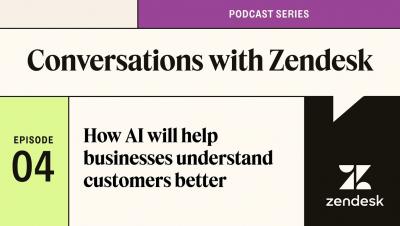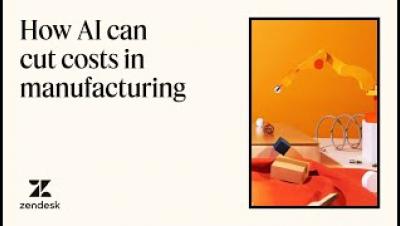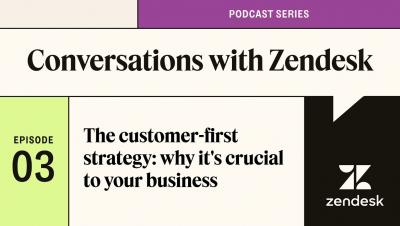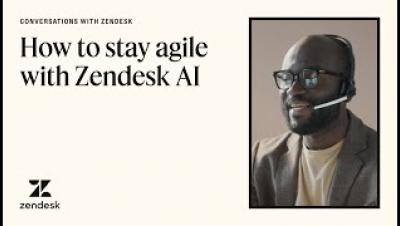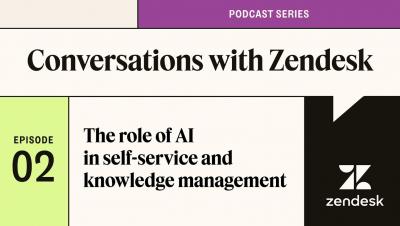Teams | Collaboration | Customer Service | Project Management
June 2023
Turbocharge your CX with Zendesk and AWS
The pandemic dealt some heavy blows to the retail industry. Lockdowns, short tempers and supply chain issues were just a few of the challenges that business owners have faced over the past three years. But retailers who got creative – and engaged with their customers in new and innovative ways – surged past the competition. Learn how to boost your retail CX with Zendesk and AWS.
How AI Can Cut Costs in Manufacturing
How AI infused immersive CX can help retailers win the battle for customer loyalty
The money in our wallets doesn’t go as far as it used to. Prices are increasing—the cost of low fat milk was around forty five per cent cheaper in December 2021 than today. Meanwhile, the phenomenon of ‘shrinkflation’, a form of hidden inflation, means we’re all paying more and getting less in return. Companies across the board, from small independent businesses right up to the biggest retailers in the country, are finding it hard too.
Deep learning vs. machine learning: what's the difference?
Understanding the latest advancements in artificial intelligence (AI) can seem overwhelming, but if it’s learning the basics that you’re interested in, you can boil many AI innovations down to two concepts: machine learning and deep learning. Examples of machine learning and deep learning are everywhere. It’s what makes self-driving cars a reality, how Netflix knows which show you’ll want to watch next and how Facebook recognises whose face is in a photo.
Shaping the future of intelligent CX with Zendesk AI
The world is changing and customer experience is shifting alongside. Advances in technology, combined with new and ongoing business challenges, put us all under pressure to continue to evolve, improve and do more for our customers. Many businesses have managed through supply chain disruptions, rising costs and the ongoing shift into the digital landscape – all while under a cloud layer of ongoing economic uncertainty. Companies are faced with tightening margins and cutting costs.
How AI is boosting agent intelligence - and evolving the CX team
Despite the hype, AI isn’t here to replace your human agents. On the contrary, when human agents and AI join forces, they form a powerful CX team – one that builds on their strengths, while minimising their weaknesses. Your agents shouldn’t be bogged down by busy work. With AI in their corner, they can instead focus on the tasks that make a difference. Which results in a better experience for all involved.
Tymeshift seamless workforce management, now in Zendesk
Prepare for the future of CX with powerful agent tools
How tech companies are using AI to control costs in 'year of efficiency'
In response to macroeconomic pressure, technology companies of all sizes have been tightening their belts and flattening their org structures. Meta CEO Mark Zuckerberg has called it the “year of efficiency”, while others are calling it the “end of the tech boom”. But despite budget challenges, tech companies have reason to hope.
How to cut retail customer service costs with artificial intelligence
The digital transformation in retail has fundamentally changed the way the entire industry operates. From supply chain management to predictive analytics, it has increased speed and efficiency across all areas of the retail business. In today’s hyper-competitive environment, agility is critical to attracting and keeping customers. Shoppers know they have choices and retailers who aim to keep their business from walking out the door need to put customers at the centre.
How manufacturers can cut service costs with AI and automation
It’s fair to say the manufacturing industry is on the fast track to digital transformation. The pandemic exposed the fragility of our global supply chains, resulting in empty shelves and overstocked warehouses. Meanwhile, as the pandemic subsides, inflation is driving up the cost of goods and logistics, putting the squeeze on companies still recovering from the past few years. So it’s no surprise that manufacturers are looking for ways to cut costs whilst still maintaining quality.
Harness the power of AI
The new frontier in finserv: immersive CX with conversational AI
Article originally published in the Altfi report, jointly sponsored by Zendesk. The landscape of customer service has never looked more different, shaped by shifting consumer behaviour and expectations that have rapidly changed over the past two years, driven in turn by the shocks and aftershocks of the pandemic, economic uncertainties, and ever evolving technology trends. Consumers’ voices are growing louder, and bolder, and what customers want is clear: immersive customer experiences.
New standard in CX-measuring customer emotions
Take a moment and think about your latest purchasing experiences. Can you recall buying a product impulsively because of excitement? Or can you remember leaving a store because of a bad experience? What was the main driver of your decisions? Harvard Business Study shows that ninety-five per cent of purchase decisions are emotional. The traditional Customer Experience (CX) metrics like NPS, CSAT, and CES only measure loyalty, service quality, and functionality.
The Customer-first Strategy: Why it's Crucial to your Business I Conversations with Zendesk Podcast
What is Employee Engagement? (+5 strategies for improving it) #ytshorts
How to stay agile with Zendesk AI
Remove repetitive tasks with AI
Zendesk for Financial Services #ytshorts
How to control customer service costs and save time
Welcome to Showcase: where we shine a light on the intelligent heart of customer experience
Customer experience is now shaping the way companies across the world do business. We’ve seen companies thrive based on their ability to listen to their customers’ needs and keep up with the latest trends. The latest developments in artificial intelligence (AI) provide a bounty of opportunities and possibilities for businesses to rise to the challenge, and deliver seamless, personalised, and immersive experiences for their consumers.
Top 8 change management models: a comparison guide
With how fast industries move, technologies advance and current events shift, organisational change is now a normal part of doing business. But change is rarely easy. And the bigger and more complex a business is, the more challenging it is to implement change effectively. Yet the ability to incorporate necessary changes into how you do business plays a direct role in long-term success.
Community tip: how to set a reminder on a ticket
It’s great to be able to put a ticket on hold but I’m sure you’ve suffered when tickets have stayed like that for too long. Sure, you could create an automation to change the state back to being open after X amount of days but life is never as simple as there being a constant value for X. And perhaps you don’t want to actually change the status – you just want to be reminded that the ticket is there.


